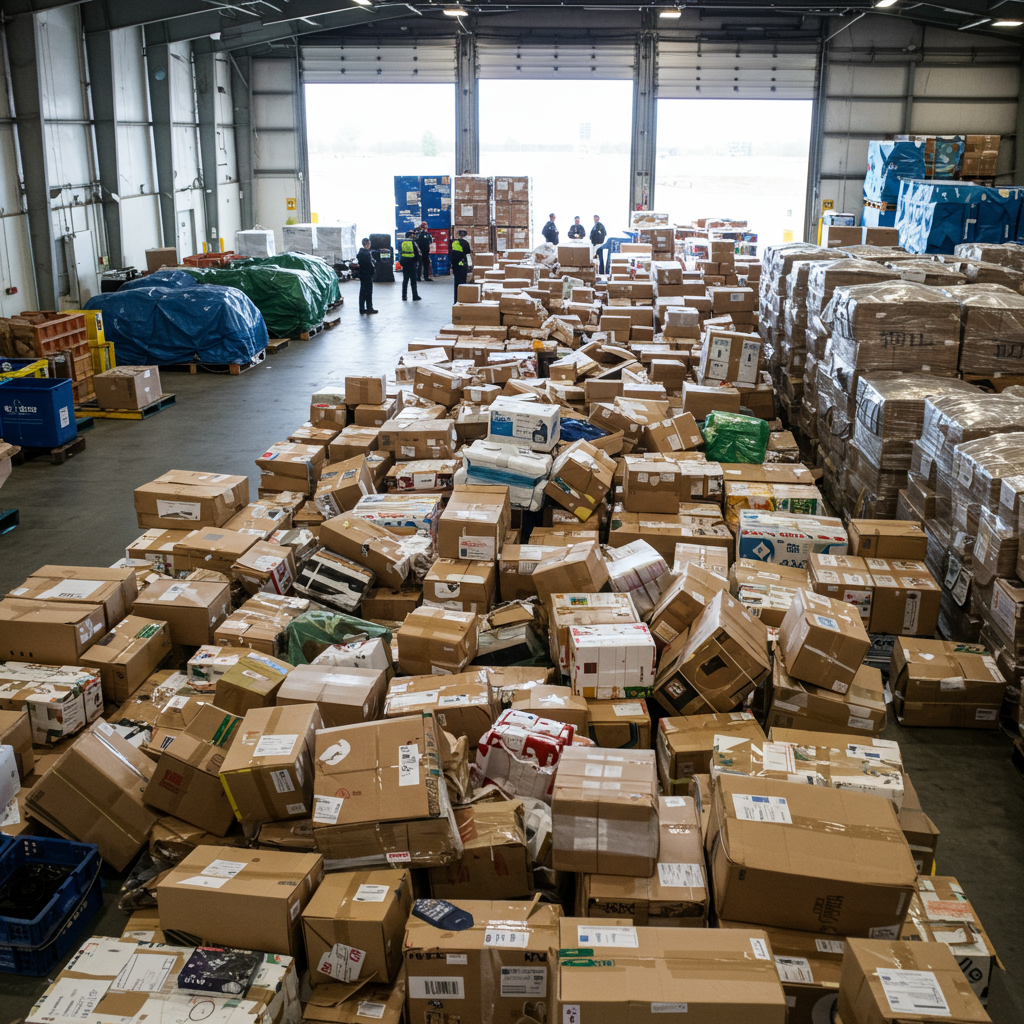A seismic shift is underway in international shipping, sending ripples through global e-commerce and personal mail. Major postal services worldwide are halting many package deliveries to the United States. This unprecedented disruption stems from a recent change in US customs rules – the elimination of the long-standing “de minimis” tariff exemption. If you send or receive parcels from abroad, understanding these urgent updates is critical. This guide breaks down why these suspensions are happening, who’s affected, the cost implications, and what practical steps you can take.
Why Global Mail Services Are Halting US Deliveries
The core of this widespread disruption lies with the Trump administration’s decision to remove the “de minimis” rule. This exemption, a Latin term meaning “too minor to be concerned with,” previously allowed packages valued under US$800 to enter the United States duty-free and without extensive customs checks. For years, it facilitated smooth, cost-effective cross-border trade.
In late July, President Donald Trump signed an executive order to abolish this privilege. The change took full effect on August 29, meaning packages arriving after this date would no longer benefit from the exemption. Instead, they would be subject to full tariff rates based on their country of origin. This policy shift dramatically increases the cost of mailing most packages to the US. International postal services now face the choice of absorbing these heightened expenses or passing them on to customers. Many have temporarily suspended services to buy time. They need to adjust their systems, understand the new regulations, and account for these significantly increased costs. The US government had already ended this exemption for imports from China and Hong Kong in early May before extending the policy globally.
Unpacking the Impact: What Types of Mail Are Affected?
It’s crucial to understand that not all mail is equally affected by these new regulations and subsequent suspensions. While the situation varies by country and specific carrier, some general patterns have emerged.
Goods vs. Letters: Key Distinctions
Many postal services are continuing to send letters and documents to the US. The primary focus of the suspensions is on packages containing goods. Specifically, items previously valued under US$800, which enjoyed the “de minimis” exemption, are now the main target of the new tariff rules.
Exemptions and Liabilities
Technically, personal gifts valued under US$100 may still be exempt from these new tariffs. However, some services have opted to suspend all postage of goods to the US, regardless of value, to simplify operations during this uncertain period. A few have even suspended all mail categories entirely.
For packages that were shipped before the August 29 deadline and arrived by that Friday, they will typically not incur new tariffs. However, if a package shipped earlier arrives after the deadline, its fate could differ. Belgium’s bpost, for instance, indicated such packages might be returned to the sender to avoid fees. New Zealand’s service, however, warned that the receiver would be held responsible for all duties and taxes. This highlights the varying policies and the need for senders and receivers to verify specific carrier guidelines.
Who’s Halted Shipments? A Global Overview
The ripple effect of these US policy changes has been swift and widespread, impacting nearly 30 countries and numerous major postal carriers by late August.
European Nations Lead the Suspensions
In Europe, at least 22 countries, including major economies like the UK (Royal Mail), France (La Poste), Germany (Deutsche Post, DHL Parcel Germany), and Italy (Poste Italiane), have suspended some deliveries. PostEurop, representing 32 additional postal services, indicated its members might also be forced to restrict shipping. DHL Parcel Germany announced a pause in the acceptance and transport of business customer parcels via the postal network to the U.S. as early as August 23. They cited unresolved questions regarding customs duty collection, required data, and data transmission methods. Similarly, France’s La Poste openly criticized the Trump administration for not providing postal operators with sufficient time to reorganize and implement necessary computer updates.
Asia and Pacific Regions Also Affected
Beyond Europe, several nations in the Asia and Pacific region have also ceased or limited their services. These include Australia (Australia Post), New Zealand, Japan (Japan Post), India, South Korea, Taiwan, and Singapore. These countries typically provide similar reasoning: the need to adapt to new rules and processes.
E-commerce Platforms React
The impact extends directly to online marketplaces. Etsy, a popular platform for unique goods, suspended its US shipping label services for major carriers like Australia Post, Canada Post, the UK’s Royal Mail, and Evri. Etsy encouraged its users to seek alternative carriers that allow for pre-payment of tariff fees, indicating a significant shift in e-commerce logistics for small businesses.
When Will International Shipping to the US Resume?
A primary concern for both senders and receivers is the timeline for resuming normal international mail services to the United States. Unfortunately, a clear end date remains elusive.
Many postal services have informed customers that US deliveries are suspended indefinitely. The interruption will last until the US government provides comprehensive details on the new import rules, allowing carriers to adapt their internal systems to match. This lack of clarity creates significant logistical challenges for global postal operators.
Anticipating Higher Costs
When services do eventually resume, a key takeaway is the near certainty of increased postage fees. Australia Post, for example, has already warned customers that fees will rise to account for new tariff and handling charges. They have partnered with a US customs-authorised payments operator to develop a new billing system, highlighting the complexity and investment required to navigate these changes.
While permanent fee structures are still being determined, all parcels will face the tariff rate imposed on their country of origin. As a temporary measure, until late February, US customs will accept an alternative fixed fee from carriers. These charges are tiered: $80, $160, or $200 per item, depending on the country’s tariff rate (under 16%, 16-25%, or over 25%, respectively). This temporary solution offers some predictability for carriers but still adds substantial cost.
The Rationale: Why Did the De Minimis Exemption End?
The removal of the “de minimis” exemption is not an isolated incident. It’s the latest in a series of reforms by the Trump administration to US trade policy, often leveraging tariffs as a diplomatic tool and a means of protecting domestic industries.
Combatting Perceived Abuse and Unfair Competition
The exemption had significantly facilitated duty-free trade around the world, allowing businesses, particularly online retailers, to sell goods at relatively lower prices if shipped in smaller bundles. US Customs data reveals the scale: in 2024, the US received an astonishing 1.36 billion packages under this exemption, containing goods valued at $64.6 billion. Online giants like Amazon, Etsy, Shein, and Temu heavily benefited from this rule, using it to ship inexpensive goods directly to US consumers.
However, US industry associations had complained for years that this “loophole” created unfair competition for domestic businesses, especially against Chinese sellers. The White House stated in April that Customs and Border Patrol processed over 4 million de minimis shipments daily, with low-value retailers like Temu and Shein alone contributing over 30% of these daily packages from China. The prior suspension of the exemption for China and Hong Kong in May reportedly nearly halved the number of US users of China-based Temu between March and May. This suggests the administration viewed the exemption as a disadvantage for American businesses.
National Security and Illicit Goods Claims
Beyond economic concerns, the White House cited national security as a justification. Following the executive order in July, a statement was released claiming the exemption had been “abused” to export illicit drugs, including fentanyl and opioids, into the US, allegedly “killing Americans.” The administration presented this as a measure to combat “escalating deceptive shipping practices, illegal material, and duty circumvention.” This dual rationale – economic protection and national security – underscores the political motivations behind the policy change.
The Far-Reaching Consequences for Consumers and Businesses
The widespread suspensions and new tariff rules are creating significant hurdles for both individual consumers and businesses engaged in international trade.
For Consumers: Higher Costs and Limited Choices
For consumers, the most immediate impact will be on their wallets. Online purchases from international retailers are now likely to become more expensive due to added tariffs and increased shipping costs. This could deter some from ordering goods from abroad or force them to pay significantly more. Shipping delays are also a likely consequence, as postal services grapple with new systems. Fewer international shipping options may also emerge as some carriers decide the complexity isn’t worth the operational burden. Consumers will need to diligently check carrier policies and be prepared for potential customs duties upon delivery, which could involve additional fees or even package returns.
For Businesses: Operational Headaches and Market Access Challenges
Small businesses, particularly those relying on cross-border e-commerce, face immense challenges. Increased operational costs, including higher postage fees and the administrative burden of new customs documentation, will cut into profit margins. Some smaller sellers might find the US market effectively closed off if they cannot find affordable, compliant shipping solutions. This could lead to a loss of market access and revenue for many.
Larger online retailers like Shein and Temu, previously heavily reliant on the de minimis rule, have already begun to adapt. Reports suggest some are shifting to a “local fulfillment model” to avoid price increases and navigate the new customs environment. This strategic pivot, however, requires substantial investment and infrastructure, a luxury not available to most small enterprises. The ambiguity surrounding duty collection, required data, and data transmission methods continues to plague all postal and parcel service providers globally, causing widespread uncertainty and disruption.
Navigating the New Landscape: Practical Steps
In this evolving situation, proactive measures are essential for anyone involved in international shipping to the US.
For Senders and Businesses:
Contact Your Carrier: The first and most critical step is to directly contact your specific postal service or preferred international courier. Ask about their current status regarding US-bound shipments, any new documentation requirements, and estimated costs.
Factor in New Costs: If you’re a business, update your pricing models to account for potential tariffs and increased shipping fees. Be transparent with your customers about these changes.
Explore Alternatives: Investigate private express carriers like DHL Express or FedEx. While often more expensive than postal services, they may offer more consistent, albeit tariff-bound, delivery options during this period. Be aware that these carriers will also apply applicable tariffs.
Understand Documentation: Ensure you have all necessary customs declarations, commercial invoices, and product classifications correctly completed to minimize delays or returns.
Consider “Gift” Options: For personal shipments, check if sending a package labeled as a “gift” under the US$100 threshold is still a viable, duty-free option with your chosen carrier.
For Receivers and Shoppers:
Expect Higher Costs: Be prepared for potential import duties and taxes on international online orders. These costs may be collected upon delivery or pre-paid by the sender, depending on the carrier’s new systems.
Track Shipments Closely: Monitor your tracking information frequently. Be aware of any customs holds or requests for additional information.
Understand Liability: Clarify with the sender who is responsible for paying duties and taxes in case of complications. Some services, like New Zealand’s, place this responsibility on the receiver.
- Check Return Policies: If a package is returned due to unpaid duties, understand the sender’s return and refund policy.
- www.theguardian.com
- www.usatoday.com
- www.newsweek.com
- m.economictimes.com
- www.nbcnews.com
Frequently Asked Questions
What is the “de minimis” exemption and why was it removed for US imports?
The “de minimis” exemption was a US customs rule that allowed goods valued under US$800 to enter the country without incurring duties, taxes, or undergoing extensive customs checks. It was removed by the Trump administration, effective August 29, 2025. The reasons cited for its abolishment included concerns about its alleged abuse to evade duties, unfair competition for domestic businesses from foreign online retailers (like Temu and Shein), and its purported use for trafficking illicit goods such as fentanyl and opioids into the United States.
Which countries and major postal services have suspended mail to the United States?
As of late August, nearly 30 countries had suspended some form of mail service to the US. This includes a significant number of European nations (around 22), such as the UK (Royal Mail), France (La Poste), Germany (Deutsche Post, DHL Parcel Germany), and Italy (Poste Italiane). In the Asia-Pacific region, countries like Australia (Australia Post), New Zealand, Japan (Japan Post), India, South Korea, Taiwan, and Singapore have also halted or restricted deliveries. Online platforms like Etsy have also been affected, suspending US shipping label services for several major carriers.
How can I send packages to the US during this suspension, and what are the cost implications?
During the suspension, options are limited. Most postal services continue to send letters and documents. Personal gifts valued under US$100 may still be exempt from tariffs, though some services have suspended all goods shipments regardless. For other items, you can explore more expensive private express carriers like DHL Express or FedEx, but these will be subject to applicable tariffs. Mail services have indicated that when they resume, postage fees will increase significantly to cover the new tariffs and handling costs. As a temporary measure until late February, US customs will accept a fixed fee ($80, $160, or $200 per item) from carriers, depending on the country’s tariff rate.
Conclusion
The suspension of international package deliveries to the United States marks a pivotal moment for global trade and e-commerce. Driven by the elimination of the “de minimis” tariff exemption, this policy shift introduces higher costs, logistical complexities, and an uncertain future for cross-border shipping. While the full, long-term impact is still unfolding, it is clear that both consumers and businesses must adapt to a new landscape of increased expenses and potentially fewer, more complex shipping options. Staying informed, understanding carrier-specific policies, and exploring alternative solutions will be crucial for navigating these significant changes. The global postal network will eventually resume full services, but likely with a revised, more costly framework for sending goods to the US.




